Douglas A-3 Skywarrior Video - Carrier Mishap
|
|
Douglas A-3 Skywarrior
A-3 (A3D) Skywarrior
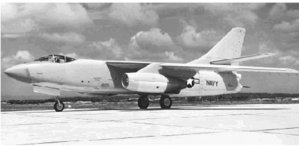
Role: Strategic bomber
Manufacturer: Douglas Aircraft Company
Designed by: Ed Heinemann
First flight: 28 October 1952
Introduced: 1956
Retired: 27 September 1991
Status: Phased out of service
Primary user: United States Navy
Produced: 1956-1961
Number built: 282
Developed into: B-66 Destroyer
The Douglas A-3 Skywarrior was originally designed as a strategic bomber for the United States Navy and was among the longest serving carrier-based jet aircraft in history. It entered service in the mid-1950s and was retired in 1991. For many years after its introduction, it was also the heaviest aircraft to enter operational status operating from an aircraft carrier (the heaviest being a USMC KC-130F BuNo 149798 that operated in a test from the USS Forrestal (CV-59) unarrested and assisted in t/o in 1963), earning it the unofficial nickname "The Whale". Its primary function for much of its later service life was as an electronic warfare platform, tactical air reconnaissance platform, and high capacity aerial refueling tanker.
A modified derivative also served in the U.S. Air Force as a tactical until the early 1970s as the B-66 Destroyer, to include EB-66 electronic warfare and RB-66 reconnaissance versions. The Skywarrior is one of only two Navy attack aircraft intended as a strategic bomber to enter service. The Martin P6M SeaMaster tested well, but never entered service due to the Navy fearing loss of funding for surface ships and submarines if it encroached on the USAF strategic bomber role. The pending elimination of the flying-boat platform from the United States Navy also entered into the decision regarding the P6M. The carrier-based supersonic A-5 Vigilante was also originally designed for strategic nuclear strike missions and initially supplanted the A-3 in that role beginning in the early 1960s. However, with the removal of aircraft carriers from the Single Integrated Operational Plan (SIOP) and the transfer of the Navy's strategic nuclear deterrence mission to the Fleet Ballistic Missile (FBM) submarine force, the Vigilante also saw its mission changed, in its case to carrier-based tactical air reconnaissance.
Development
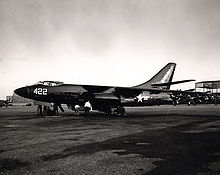
Picture - A3D-1 at NAS Jacksonville, Florida in the 1950s
Early in World War II, the Navy began to explore the concept of a jet-powered aircraft operating from aircraft carriers. Success encouraged further development of the concept, and early in the post war years the Navy began to consider jet power as a possible means of operating from carriers, aircraft that were large enough to provide a strategic bombing capability.
In January 1948, the Chief of Naval Operations issued a requirement to develop a long-range, carrier-based attack plane that could deliver a 10,000 lb (4,536 kg) bomb load or a nuclear weapon. The contract which the Navy awarded to the Douglas Aircraft Company on 29 September 1949 led to the development and production of the A3D Skywarrior. It was designed by Ed Heinemann, also to win fame for the A-4 Skyhawk. The prototype XA3D-1 first flew on 28 October 1952.
Considerable development problems, largely with the original engines, delayed the introduction of the Skywarrior until spring 1956. The A-3 was, by far, the largest and heaviest aircraft ever designed for routine use on an aircraft carrier, though ironically it was the smallest proposal among other proposals which could only be deployed on even larger carriers not yet in service. For storage below deck, the A-3's wings folded upward outboard of the engines, lying almost flat, and in order to accommodate the tall tail, its vertical stabilizer was hinged to starboard. Because of its cumbersome size, and less-than-slender profile, it was nicknamed "The Whale" (after it converted to the electronic warfare role, it became "The Electric Whale"). Production ended in 1961.
Design
The Skywarrior had a 36° degree swept wing and two Pratt & Whitney J57 turbojet engines. Early prototypes had used the intended Westinghouse J40, a powerplant that proved to be disastrous and subsequently canceled. The turbojets could be supplemented by a provision for twelve 4,500 lbf (20 kN) thrust JATO bottles, allowing takeoff from carriers that did not have catapults. The aircraft had a largely conventional semi-monocoque fuselage, with the engines in underwing nacelles. Flight controls were hydraulic, and both wings and vertical tailfin could fold for carrier stowage. Capacious internal fuel tanks provided long range.
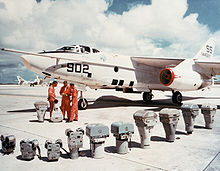
Picture - Camera arrangement of a RA-3B of Heavy Photographic Squadron SIX ONE (VAP-61) in 1965
The early A-3 variants had a crew of three: pilot, bombardier/navigator (BN) and crewman/navigator (aka: third crewman). An unusual cockpit configuration was incorporated with the three crew sitting under a framed canopy. In the raised compartment, the pilot and bombardier/navigator sat in a side-by-side arrangement with the pilot's station on port side having full flight controls. On initial variants, a third crew member, who also acted as a gunner for the twin tail-mounted 20mm cannons that equipped early versions of the the A3D/A-3B, sat behind the duo in an aft-facing seat. The third crewman station had the sextant for celestial navigation and the defensive electronic counter measures equipment. Later electronic counter-measures variants could accommodate a crew of seven with flight crew consisting of a pilot, co-pilot and navigator plus four electronic systems operators occupying stations in the former bomb bay in the sumptuous fuselage.
Efforts to reduce weight had led to the deletion of ejection seats during the design process for the Skywarrior, based on the assumption that most flights would be at high altitude. A similar arrangement with an escape tunnel had been used on the F3D Skyknight. Aircrews began joking morbidly that "A3D" stood for "All Three Dead" (in 1973, the widow of a Skywarrior crewman killed over Vietnam sued the McDonnell Douglas Aircraft Company for not providing ejection seats in the A-3). In contrast, the USAF B-66 Destroyer was equipped with ejection seats throughout its service life.
Documented history of mechanical failures in the A3D / A-3 showed a rate well above average. While there were magazine articles that conjectured that the safety problem was compounded by assigning weaker pilots to slower jets like the A-3, during their heyday, Skywarrior pilots were often "best-of-the-best" due to its critical nuclear strike mission role.
The Skywarrior could carry up to 12,000 lb (5,443 kg) of weaponry in the fuselage bomb bay, which in later versions was used for sensor and camera equipment or additional fuel tanks. An AN/ASB-1A bomb-director system was initially installed, later replaced by a revised AN/ASB-7 with a slightly reshaped nose. Defensive armament was two 20 mm (.79 in) cannon in a radar-operated tail turret designed by Westinghouse, usually removed in favor of an aerodynamic tail fairing. While some bombing missions would be carried out early in the Vietnam war, most bombing would be carried out by more nimble attack and fighter bombers, and the Skywarrior would serve mostly as a tanker and electronic warfare support aircraft.
Operational history
Nuclear bomber
Prior to the initial operational capability of the U.S. Navy's Polaris-armed Fleet Ballistic Missile submarines, the A-3 was the Navy's critical element in the US nuclear deterrent. Squadrons were established in two Heavy Attack Wings (HATWINGs), with one wing established at NAS Whidbey Island, Washington while the other wing was initially established at NAS Jacksonville, Florida before relocating to NAS Sanford, Florida. The wing at NAS Whidbey Island would later transition to the EA-3 variant, eventually forming the nucleus for the Navy's EA-6B Prowler community, while the wing at NAS Sanford would convert to the A3J Vigilante in the nuclear heavy attack mission, followed by conversion to the RA-5C and transition to the reconnaissance attack mission. The Vigilante wing would also continue to retain a small number of TA-3B aircraft for training Naval Flight Officers in the Vigilante's radar and navigation systems. The Skywarrior's strategic bombing role faded quickly after 1960, briefly replaced by the A3J Vigilante (later redesignated as the A-5A Vigilante) until 1964. Soon after that, the Navy abandoned the concept of carrier-based strategic nuclear weaponry with the success of the Polaris missile-equipped Fleet Ballistic Missile (FBM) submarine program and all A-5As were converted to the RA-5C Vigilante reconnaissance variant.
Vietnam
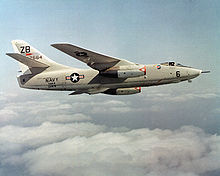
Picture - KA-3B assigned to Heavy Attack Squadron FOUR (VAH-4) on the USS Hancock (CV-19) in 1967
Skywarriors saw some use in the conventional bombing and mine-laying role during the Vietnam War from 1965 through 1967. The Navy would soon use only more nimble fighter sized attack bombers over Vietnam, but the A-3 found subsequent service in the tanker, photographic reconnaissance, and electronic warfare roles. Equipped with a drogue refueling hose and basket that was compatible with the "probe and drogue" refueling systems of all U.S. Navy, U.S. Marine Corps and some U.S. Air Force tactical jets, the Skywarrior would not only extend the range of a strike force, but save returning pilots short on fuel, much like the larger and more well known USAF KC-135 Stratotanker.
For most of the Vietnam War, EA-3Bs of Fleet Air Reconnaissance Squadron ONE (VQ-1) flew from Da Nang Air Base in South Vietnam, providing continuous electronic warfare capability over the area, including the so-called Ho Chi Minh trail and all the way north to Haiphong harbor. This was known as VQ-1 "Det B". The aircrew and ground support personnel were TAD from their home base at NAS Atsugi, Japan and after 1970, NAS Agana, Guam. After Det B was disestablished, VQ-1 provided detachments of two EA-3B aircraft that deployed with Western Pacific and Indian Ocean (WESTPAC/IO) bound aircraft carrier battle groups up until the late 1980s when it was replaced by the ES-3A Shadow.
In addition, a version of the A-3B was modified into the RA-3B and used in Vietnam as a photo reconnaissance aircraft. Heavy Photographic Squadron SIXTY-ONE (VAP-61) at NAS Agana, Guam and sister squadron VAP-62 at NAS Jacksonville, Florida furnished crews and flew out of Da Nang AB performing mapping and intelligence gathering flight over the Southeast Asia area. With 12 camera stations the RA-3B was well equipped to perform cartographic mapping of areas where no detail maps existed. With IR gear installed, the RA-3B was used at night to monitor the movement of troops down roads and trails in Laos. Other locations included Det Tango at Don Muang Royal Thai Air Force Base in Bangkok, Thailand, Det Southpaw at RAAF Base Townsville, Australia, as well as work out of Osan Air Base, South Korea.
Tanker role
During Vietnam, the Skywarrior was modified into a multimission tanker variant, the EKA-3B, that was a real workhorse for the carrier air wing. A-3 attack aircraft were modified to KA-3 tankers. Electronic jamming equipment was added without removing tanker capability so the EKA-3 could jam enemy RADAR while waiting to refuel tactical aircraft. Buddy tanking using A-4 Skyhawks and A-7 Corsair IIs, and inflight refueling using A-3 Skywarriors was utilized by the U.S. Navy in the Vietnam theater of operations from at least 1966 through 1973. Eventually, the EKA-3B was replaced by the smaller dedicated KA-6D Intruder tanker, which although it had less capacity and endurance, were more numerous in number with each carrier's air wing. Two additional Naval Reserve units were established in the early 1970s as air refueling squadrons, VAK-208 and VAK-308, at NAS Alameda, California. Both units operated aircraft with electronic warfare equipment removed and were redesignated as KA-3Bs. VAK-208 and VAK-308 were decommissioned in the early 1990s.
Cold War
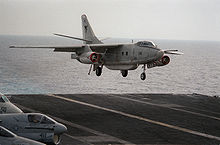
Picture - An EA-3B of Fleet Air Reconnaissance Squadron TWO (VQ-2) lands on the USS Kitty Hawk in 1987
The EA-3 variant was an indispensable resource for the Fleet Commander and was used in critical ELINT role operating from aircraft carrier decks and ashore supplementing the larger EP-3. Its last service was as an ELINT platform during Desert Storm.
Spy plane
The EA-3B model was modified for electronic intelligence against the Warsaw Pact. Missions were flown around the globe beginning in 1956, with the U.S. Air Force EB-47 Stratojet flying a similar mission. The EA-3B carried a crew of seven, with flight crew of three in the cockpit and an Electronic Warfare Officer and three electronic systems operators/evaluators in the converted weapons bay. It offered unique electronic reconnaissance capabilities in numerous Cold War-era conflicts and the Vietnam War.
Retirement
For more than three decades, the 282 Skywarriors the Navy procured served effectively in many roles with the last USN Skywarriors retiring on 27 September 1991. Navy RDT&E units, notably Naval Air Systems Command (NAVAIR) activities at NAS Point Mugu and NAWS China Lake, attempted to retain their A-3 testbeds. This plan ultimately failed when Vice Admiral Richard Dunleavy, as Deputy Chief of Naval Operations for Air Warfare and an old A-3 bombardier/navigator himself, made the decision to retire the type final.
Post-retirement career
In an agreement Hughes Aircraft had with the Navy, the Navy agreed to retain at least one A-3 aircraft in inviolate storage at Davis-Monthan AFB for long term support for major structural parts. Westinghouse also operated an A-3 in a similar arrangement.
The NAVAIR Weapons System Manager, who participated in the drafting of the contract, saw that support as no longer possible and Hughes was contacted to meet with Westinghouse and Raytheon to finalize plans for the support shutdown of the aircraft. At the last Integrated Logistics meeting at NAS Alameda, California, both Raytheon and Hughes indicated their willingness to obtain fleet A-3 Skywarrior assets instead of sending them to Davis-Monthan AFB, Arizona, thereby saving the airframes from destruction and saving the Navy the cost of storage at AMARC.
As the plan matured, two other contractors, Thunderbird Aviation and CTAS also elected to participate in similar agreements. The fleet spares from ASO were distributed between the contractors evenly, and warehouses were emptied all over the United States. Unfortunately, due to misunderstandings and reorganizations within the Navy, the world wide ASO assets were scrapped, not getting to the contractors. In early 1993, CTAS decided that they no longer had use for their aircraft, and Hughes had several programs needing additional assets.
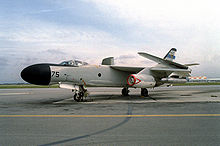
Picture - NRA-3B of the "Pacific Missile Test Center" in 1982
In early 1994, a USAF program decided to modify an A-3 for F-15 Radar tests, and the only available airframe was stored at NAS Alameda since the fleet shutdown. Hughes added that aircraft to the bailment, and ferried the aircraft to Van Nuys for modifications. An entire nose section was removed from a stricken F-15B at AMARC at Davis-Monthan AFB, Arizona and grafted onto the front of the aircraft. Racks and equipment were installed in the cabin, and the aircraft is utilized by Hughes and the USAF for F-15 software development.
In 1994, Westinghouse decided to terminate their agreement with the Navy, and Thunderbird added their aircraft to the Thunderbird bailment. In 1996, Thunderbird Aviation went into receivership, and Hughes, through mutual cost savings to the Government, added the Thunderbird assets to the contract, prepping them for ferry at Deer Valley airport, and relocating them to Mojave, California and Tucson, Arizona for long term storage.
In December 1996, Raytheon bought the aerospace units of Hughes Aircraft Company. Hughes Aeronautical Operations, now a part of Raytheon Systems, continues to operate the A-3s from their base at Van Nuys Airport, California. These aircraft have participated at several military air shows, telling visitors that the plane continued to be valuable for its load capacity compared to corporate jets, and its performance compared to small airliners.
Variants
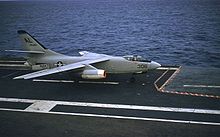
Picture - An A3D-1 of Heavy Attack Squadron THREE (VAH-3) on the USS Franklin D. Roosevelt in 1957. VAH-3 was the Replacement Air Group (RAG) squadron for the Atlantic Fleet A3D/A-3 community.
Note: under the original Navy designation scheme, the Skywarrior was designated A3D (third Attack aircraft from Douglas Aircraft). In September 1962, the new Tri-Services designation system was implemented and the aircraft was redesignated A-3. Where applicable, pre-1962 designations are listed first, post-1962 designations in parentheses.
XA3D-1: Two prototypes with Westinghouse J40 turbojets, no cannon in tail turret.
YA3D-1 (YA-3A): One pre-production prototype with Pratt & Whitney J57 engines. Later used for tests at the Pacific Missile Test Center.
A3D-1 (A-3A): 49 initial production versions, serving largely in developmental role in carrier service.
A3D-1P (RA-3A): One A3D-1 converted as a prototype for the A3D-2P with camera pack in the weapon bay.
A3D-1Q (EA-3A): Five A3D-1s converted for the electronic reconnaissance (ELINT) role, with ECM equipment and four operators in weapons bay.
A3D-2 (A-3B): Definitive production bomber version, with stronger airframe, more powerful engines, slightly larger wing area (812 ft²/75 m² versus 779 ft²/72 m²), provision for in-flight refueling reel for tanker role. Final 21 built had new AN/ASB-7 bombing system, reshaped nose; deleted tail turret in favor of electronic warfare installation.
A3D-2P (RA-3B): 30 photo-reconnaissance aircraft with weapons bay package for up to 12 cameras plus photoflash bombs. Increased pressurization allowed camera operator to enter the bay to check the cameras. Some retained tail guns, but most were later converted to ECM tail of late A-3Bs.
A3D-2C (EA-3B): 24 electronic warfare versions with pressurized compartment in former weapon bay for one Electronic Warfare Officer and three ESM operators, various sensors. This was the longest serving version of the "Whale" and the most widely known throughout the fleet. Some early models had tail guns, but these were replaced with the ECM tail. The EA-3B was assigned to fleet reconnaissance squadrons VQ-1 (Japan and later Guam) and VQ-2 (Rota. Spain) where they flew alongside the EC-121 and the EP-3B and EP-3E. It served in the fleet for almost 40 years, and was replaced by the ES-3A Shadow flown by two Fleet Air Reconnaissance (VQ) squadrons: VQ-5 at NAS North Island, California and VQ-6 at NAS Cecil Field, Florida. They were decommissioned less than 10 years after their commissioning due to budget constraints.
A3D-2T (TA-3B): 12 bomber-trainer versions. Five later converted as VIP transports (two redesignated UTA-3B).
KA-3B: 85 A-3B bombers refitted in 1967 for the tanker role with probe-and-drogue system in place of bombing equipment.
EKA-3B: 34 KA-3B tankers refitted for dual ECM/tanker role, with electronic warfare equipment and tail fairing in place of rear turret. Most were converted back to KA-3B configuration (with no ECM gear) after 1975.
ERA-3B: Eight RA-3Bs converted as electronic aggressor aircraft (primarily for war-at sea exercises) with ECM in new extended tail cone, ventral "canoe" fairing, cylindrical fairing atop vertical fin, and two detachable ram-air turbine powered ALQ-76 countermeasures pods (one under each wing). Added Chaff (radar countermeasure) dispensers (streaming chaff from the tail cone and two self-protection chaff dispensers on the aft fuselage) and four ram-air turbines (two per side) to power the equipment located in the former "Flash Bomb" bay. Crew increased to FIVE (Pilot, Navigator, Crew Chief, Electronic Countermeasures Officer (ECMO) and Enlisted Warfare Operator (EWO) (both positions known as Electronic Countermeasures Evaluators), in the aft crew compartment (formerly the camera compartment). While the ERA-3B could withstand the stresses of a cable arrested landing, the ALT-40 and ALR-75 equipment in the former photographic "Flash Bomb" bay was not stressed to withstand a catapult launch and the ERA-3B was never deployed aboard ship. The ERA-3B served with VAQ-33 and later with VAQ-34.
NRA-3B: Six RA-3Bs converted for various non-combat test purposes.
VA-3B: Two EA-3B converted as VIP transports. Both aircraft were assigned to the Chief of Naval Operations flying from Andrews AFB in Washington, DC.
NTA-3B: One aircraft converted by Hughes/Raytheon used to test radar for the F-14D Tomcat.
B-66 Destroyer
The U.S. Air Force ordered 294 examples of the derivative B-66 Destroyer, most of which were used in the reconnaissance and electronic warfare roles. The Destroyer was fitted with ejection seats.
Operators
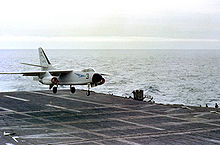
Picture - An A3D-2 of Heavy Attack Squadron SIX (VAH-6) lands on the USS Ranger in 1958
United States
United States Navy
VAH-1 based at NAS Sanford, FL (later RVAH-1, now decommissioned)
VAH-2 based at NAS Whidbey Island, WA (now VAQ-132)
VAH-3 based at NAS Sanford, FL (later RVAH-3, now decommissioned)
VAH-4 based at NAS Whidbey Island, WA (now VAQ-131)
VAH-5 based at NAS Sanford, FL (later RVAH-5, now decommissioned)
VAH-6 based originally at NAS North Island, CA,
moved to NAS Whidbey Island, WA 1958, then moved to NAS Sanford, FL
(later RVAH-6, now decommissioned)
VAH-7 based at NAS Sanford, FL (later RVAH-7, now decommissioned)
VAH-8 based at NAS Whidbey Island, WA (now decommissioned)
VAH-9 based at NAS Sanford, FL (later RVAH-9, now decommissioned)
VAH-10 based at NAS Whidbey Island, WA (now VAQ-129)
VAH-11 based at NAS Sanford, FL (later RVAH-11, now decommissioned)
VAH-13 based at NAS Sanford, FL (later RVAH-13, now decommissioned)
VAH-123 based at NAS Whidbey Island, WA (now decommissioned)
VAW-13 based at NAS Agana, Guam (now decommissioned)
VAQ-129 based at NAS Whidbey Island, WA (now flying the EA-6B & EA-18G)
VAQ-130 based at NAS Whidbey Island, WA (now flying the EA-6B)
VAQ-131 based at NAS Whidbey Island, WA (now flying the EA-6B)
VAQ-132 based at NAS Whidbey Island, WA (now flying the EA-18G)
VAQ-133 based at NAS Whidbey Island, WA (now flying the EA-6B)
VAQ-134 based at NAS Whidbey Island, WA (now flying the EA-6B)
VAQ-135 based at NAS Whidbey Island, WA (now transitioning to the EA-18G)
VAQ-33 based at NAS Key West, FL (now decommissioned)
VAQ-34 based at NAS Point Mugu, CA (now decommissioned)
VAK-208 based at NAS Alameda, CA (now decommissioned) (Naval Reserve)
VAK-308 based at NAS Alameda, CA (now decommissioned) (Naval Reserve)
VAP-61 based at NAS Agana, Guam (now decommissioned).
VAP-62 based at NAS Jacksonville, Florida (now decommissioned)
VQ-1 based at NAS Agana, Guam (now based at NAS Whidbey Island, WA flying only the EP-3E)
VQ-2 based at NS Rota, Spain (now based at NAS Whidbey Island, WA flying only the EP-3E)
VR-1 based at NAS Patuxent River, MD and Andrews AFB/NAF Washington, MD
VX-5 based at NAWS China Lake, CA with detachment at NAS Sanford, FL
National Parachute Test Range based at NAF El Centro, CA
Naval Air Development Center based at NADC Johnsville/NADC Warminster, PA (activity and installation now decommissioned)
Naval Air Test Center at NAS Patuxent River, MD
Pacific Missile Test Center at NAS Point Mugu, CA
Survivors
In addition to the A-3s currently bailed by the Navy to Raytheon Systems in support of NAVAIR and other DoD flight test programs, additional A-3s are currently on static display at several locations. These locations include the:
National Museum of Naval Aviation at NAS Pensacola, Florida
NAS Key West, Florida
Patriot's Point on board the decommissioned USS Yorktown (CV-10) at Mount Pleasant, South Carolina
Pima Air and Space Museum, adjacent to Davis-Monthan AFB in Tucson, Arizona
USS Midway (CV-41) Museum in San Diego, California
National Cryptologic Museum's National Vigilance Park at Fort Meade, Maryland
New England Air Museum at Bradley International Airport, Connecticut
USS Alabama Battleship Memorial Park in Mobile, Alabama (this EA-3B aircraft was previously displayed in front of the Daum Hall BOQ at Naval Station Rota, Spain)
Oakland Aviation Museum at Oakland International Airport, California (KA-3B on display)
Castle Air Museum at former Castle AFB, California (RA-3B undergoing restoration)
Fulton County Airport in Johnstown, NY on display at airport entrance. Previously displayed on the decommissioned aircraft carrier USS Intrepid (CV-11)
When released by Raytheon and NAVAIR, additional A-3s are also programmed by the National Museum of Naval Aviation for relocation to NAS Whidbey Island, Washington for display near the NAS Whidbey main gate, and to the Orlando Sanford International Airport, which is the former NAS Sanford, Florida, for eventual display adjacent to the airport's RA-5C Vigilante.
Specifications (A3D-2/A-3B Skywarrior)
General characteristics
Crew: 3
Length: 76 ft 4 in (23.27 m)
Wingspan: 72 ft 6 in (22.1 m)
Height: 22 ft 9.5 in (6.95 m)
Wing area: 812 ft² (75.4 m²)
Empty weight: 39,400 lb (17,900 kg)
Loaded weight: 70,000 lb (31,750 kg)
Max takeoff weight: 82,000 lb (37,200 kg)
Powerplant: 2x— Pratt & Whitney J57-P-10 turbojet, 10,500 lbf (46.7 kN) each
Performance
Maximum speed: 530 kn (610 mph, 980 km/h)
Cruise speed: 450 kn (520 mph, 840 km/h)
Range: 1,325 mi (2,130 km)
Service ceiling: 41,000 ft (12,500 m)
Wing loading: 86.2 lb/ft² (421 kg/m²)
Thrust/weight: 0.30
Armament
Guns: 2x— 20 mm (0.79 in) M24 cannons in the tail turret (later deleted due to maintainability/reliability issues)
Bombs: 12,000 pounds (5,443.1 kg) of free-fall bombs, including any combination of
12 x— 500 pounds (226.8 kg) Mark 82 bombs or
6x— 1,000 pounds (453.6 kg) Mark 83 bombs or
1,600 pounds (725.7 kg) armor-piercing bombs or
500 pounds (226.8 kg) Mark 36 DST Destructor Mines or
1,000 pounds (453.6 kg) Mark 40 DST Destructor Mines or
2,000 pounds (907.2 kg) Mark 41 DST Destructor Mines or
1x— Mark 15 free-fall nuclear weapon or
1x B43 free-fall nuclear weapon
Related development
Douglas B-66 Destroyer
Comparable aircraft
Ilyushin Il-28
Sud Aviation Vautour
Yakovlev Yak-28
Bibliography
Ciampaglia, Giuseppe. Bombardieri Attomici Strategici della US Navy (in Italian). Rome: Rivista Marittima, 2006.
Donald, David and Jon Lake, eds. Encyclopedia of World Military Aircraft. Westport, Connecticut: AIRtime Publishing, 1996. ISBN 1-880588-24-2.
Winchester, Jim, ed. "Douglas A-3 Skywarrior." Military Aircraft of the Cold War (The Aviation Factfile). London: Grange Books plc, 2006. ISBN 1-84013-929-3.
Douglas A-3 Skywarrior Pictures
More aircraft.
Source: WikiPedia